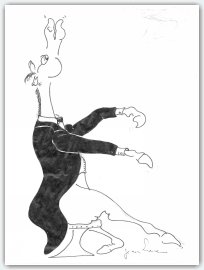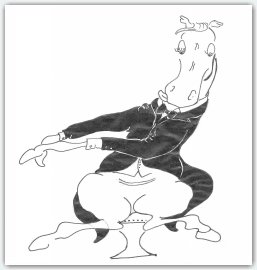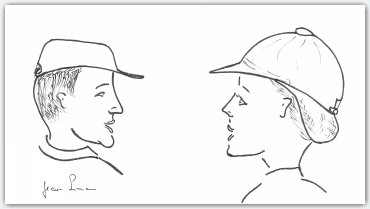Volitional Learning
More on Volitional Learning
In Hand Dressage Training
Equine Biomechanics



“First he learns all the postures of Beethoven’s Fifth Symphony and then, we bring the piano”.
Cartoons by Jean Luc Cornille. Copyright reserved
There is, effectively, very little chance that the above teaching technique would work. However, this is basically the approach of conventional equitation. One learns the position, the correct aids and then the horse is supposed to know the music. Again, effectively, it does not work; only very few riders reach a standard of feel and proficiency allowing them to use their seat efficiently. The problem is not the riders’ sensitivity and skill. Instead, the culprit is the teaching. By contrast, practically every rider that studies through volitional learning, as practiced at Science of Motion, develops the body language necessary to lead the horse’s brain toward the proper body coordination appropriate for the effort
In our performance and lameness analysis program, we receive, every week, videos of lame horses or equine athletes demonstrating difficulties with performance. Often the rider or horse’s owner also sends a video of the horse prior to the perceived problem. Invariably, the problem was there all along. It was at first a mild kinematics abnormality, which went undetected. Almost also invariably, the rider had felt that something was wrong, but it was dismissed by the trainer or the vet who was unable to see the problem. Veterinarians are educated to treat lameness, not to prevent it. Most trainers only know the judging standards and therefore train without adequate knowledge of the body coordination that allows the horse to perform soundly. Basically, most equestrian education fails both the horse’s talent and the rider’s proficiency and feel.
Today’s equine research studies provide advanced understanding of equine physiology as well as the capacity to apply this knowledge. Active learning greatly enhances one’s proficiency. It is very well-known for instance, that the driver of a car is more likely to remember directions than the passenger. Volitional control is the most advanced learning technique for both humans and equines. It is about engaging the intelligence and learning through the active participation of human and equine mental processing. For humans, the technique has shown great improvement in terms of memory encoding and engagement of different parts of the brain in decision making. For equines, the technique is even more efficient since animals in actuality only learn actively rather than passively. Actively does not mean just physical activity. A rider learning the “correct position” on the lunge line is physically active but mentally passive in the sense that the body and the brain are only enduring the horse’s movement in the single capacity of trying to stay on. Active learning is about never dissociating the rider’s position form the purpose of the rider’s position, which is communicating with the horse. A horse rushed 100 miles per hour around the ring is physically active but mentally passive. Speed and excessive weight on the forehand hamper the horse’s ability to find authentic balance and sound forward motion. The horse becomes a victim enduring the session with the brain working only at the level of survival reflexes instead of participating in the decision making.
“Natural Horsemanship” approaches are beneficial in the sense than they make riders aware of the fact that a horse does have personality and emotion. However, they are only useful at elementary level. When it comes to educating the horse’s physique, these approaches direct the rider’s thinking in the wrong direction. The problem for the horses is that the body coordination that allows them to perform while carrying a rider is not included in their genetic heritage. They have to explore, in their brain, combinations of reflexes that are far more sophisticated than their natural combination of reflexes. The rider needs to question the horse’s brain and assist the horse as he explores mentally appropriate solutions. This has nothing to do with the relationship that horses have in the establishment of the social order when they are together in the field. We humans are not brood mares or stallions when dealing with a horse. We are humans that have undertaken the responsibility to awaken, stimulate and guide the horse’s intelligence. Little by little all of the principles which, have been accepted as the corner stone of equestrian education, have to be updated to actual knowledge.
The purpose of mastering the rider’s body is no longer for the correct application of aids, which, for the horse, is merely passive learning. But instead, the mastery of the rider’s body allows the clarity of a language, which leads the horse’s brain toward the coordination best appropriate for the nature of the effort. The thought that the correctness of the rider’s aids guarantees the correctness of the horse’s response is infantile. The horse responds to the rider’s aids the way he runs every event in his life, which is to protect any actual muscle imbalance, morphological flaw or other problem. For instance, before he was even touched by humans, “The Horse That Could Not Trot” had already developed a heavy compensation mechanism that rendered him debilitated. The first sequence of the video (of the same title) shows the horse as he was ridden for the fourth or fifth time. The horse is already so crooked that he could not trot. There was no pathological change, no bone or soft tissue damage, simply the development and buildup of protective reflex contractions leading to total body impotence. Without being as dramatic, the same mental processing is how the horse’s mind responds to the rider’s aids. A rider can learn the aids of the shoulder in, as well as the judging standards of the shoulder in, yet still never be cognizant nor able to teach the body coordination that allows the horse to actually benefit from the gymnastic effect of this movement.
Active learning commences with a sound understanding of the performance’s athletic demands, (where the horse’s thoracolumbar column bends, which conditions render lateral bending efficient, etc.). Active learning continues giving, to the horse, some volitional control, which engages the horse’s mind in the search for the appropriate body coordination. For instance, lateral bending is always associated with a movement of transversal rotation. The rotation can be proper or inverted. In theory, transversal rotations, which are also referred to as axial rotations, should be even on each side of a hypothetical vertical axis. In reality, preferential rotation exists in every horse, which quite often leads to one lateral bend associated with the correct rotation and the other lateral bend associated with an inverted rotation. Correcting inverted rotation demands the participation of the horse’s mental processing. All predefined aids are ineffective because the horse will respond to the aids by protecting its inverted rotation. The mistake that is often made, of increasing the lateral bending of the neck, will in fact, stimulate inverted rotation. The aids commonly emphasized such as the inside leg and outside rein may influence the overall body posture but will not have any effect on the inverted rotation. Only the rider’s appropriate questions, may directed the horse’s brain toward the right coordination.
Right shoulder in might be the appropriated question. If for instance, the right lateral bend is associated with an inverted rotation that shifts the dorsal spines to the left, (this rotation is referred to as a right rotation because the ventral part of the vertebral bodies is facing right), adduction of the right hind leg toward the median line might be an effective gymnastic move. Adduction of the right hind leg demands lowering of the right hip and therefore a transversal rotation of the pelvic lowering the right hip. The pelvic does not turn around the sacrum. Only infinitesimal movements occur between the pelvic and the sacrum. Pelvic rotation is in fact a rotation of the entire thoracolumbar column, which might correct the orientation of the horse’s dorsal spines.
However, a horse can execute some light adduction of the right hind leg even if the thoracolumbar spine and pelvis are rotated in the wrong direction. In such is the horse’s reaction, a better question might be left shoulder in. Transversal rotation shifts the tip of the dorsal spines toward the inside of the bend. The shift is very light. In fact, the dorsal spines are more vertical than truly inclined toward the inside of the bend. If the horse travels naturally with the dorsal spines permanently inclined to the left, left lateral bending might incite the horse to replace his dorsal spine in a more vertical posture and consequently correct the transversal rotation. It belongs to the rider to find the question that will likely lead the horse’s brain to the right response. It belongs to the horse to explore solutions refining his body coordination and therefore, rendering the performance easier to complete.
From the decision of the right or left shoulder in to the education of the body coordination rendering the shoulder in effective, the difference between conventional and intelligent education is about engaging the horse’s intelligence. It is also about understanding the athletic demand of the performance. Conventional education believes that repeating the movement does educate the horse’s body. Instead, intelligent education understand that without guiding the horse’s brain toward the body coordination specifically adapted to the athletic demand of the performance, dressage movements are senseless compulsories.
Without this level of education, both the rider and the horse have very little chance to discover more than a small percentage of their full potential. The rider deserves a better education and the horse deserves a better education. Volitional learning for both the rider and the horse is strongly emphasized in out In Hand Therapy Course, (IHTC).
Jean Luc Cornille



 twitter
twitter facebook
facebook digg
digg google
google stumbleupon
stumbleupon myspace
myspace yahoo
yahoo linkedin
linkedin blogger
blogger